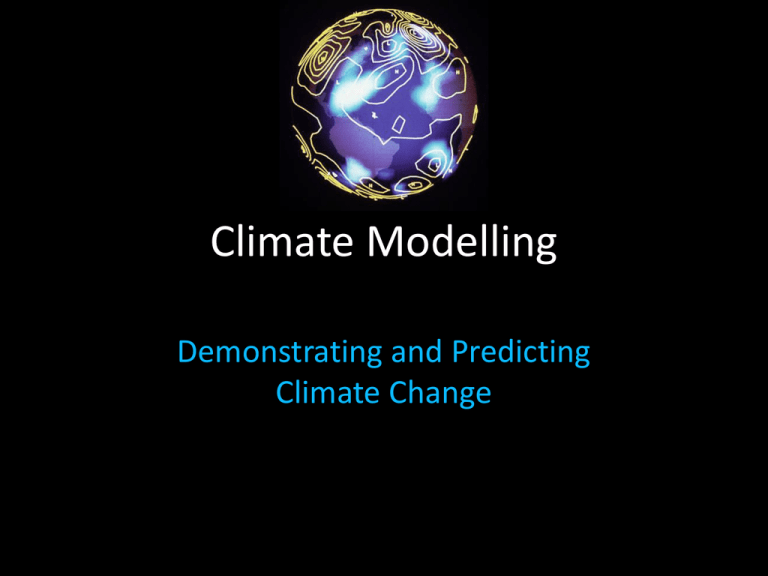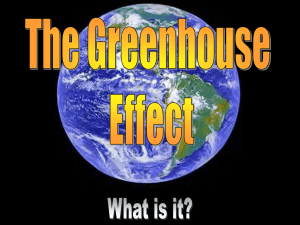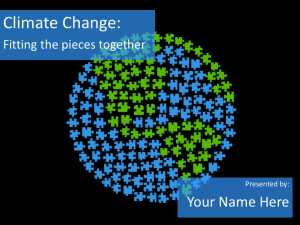Climate Modelling Demonstrating and Predicting Climate Change
advertisement

Climate Modelling Demonstrating and Predicting Climate Change How Do We Know Today’s Changes Aren’t Natural? • Today, scientists are more than 90 % certain that current changes in climate are due to human emissions of greenhouse gases. • How do scientists know that today’s changes are human-caused, and not natural? 1. They develop complex computer models of the climate system to test the effects of different factors on the climate system. 2. They compare current changes to changes that have happened in the past. Scenario 1: Natural Changes Only • This scenario models an Earth with only natural factors affecting climate. • The scenario includes natural changes in the Sun’s energy, volcanic eruptions, and natural emissions of greenhouse gases. Scenario 2: Natural and Anthropogenic Factors • This scenario includes both natural factors and human emissions of greenhouse gases. Which scenario fits observed data? More models, same conclusion What is the conclusion? • Scenario #2, including human emissions of greenhouse gases, matches real-life observations very closely. This shows that human emissions of greenhouse gases are affecting the global climate. • Are today’s changes greater than natural changes in the past? • Greenhouse gas levels in the atmosphere are higher today than they have been for the last 800 000 years. Hasn’t it been hot in the past? • Although Earth’s temperature is not yet higher than it has been in the past 800 000 years, scientists are concerned that the high levels of greenhouse gases will cause Earth to warm up very quickly over the next 100 years. • Temperatures 1°C – 2°C warmer may have been suitable for past ecosystems, but humans have evolved and adapted to current climate conditions What about the future? • A climate projection is a scientific estimate of future climate conditions • Also called GCMs (general circulation models, or global climate models) they are based on many variables such as: – Nutrient cycles (especially carbon and water) – Concentrations of GHGs and how they will change – Positive and negative feedback loops – Ocean currents, and wind currents GCMs • Represent the physical processes in the atmosphere, ocean, cryosphere and land surface • GCMs depict the climate using a three dimensional grid over the globe Uncertainty in GCMs • some physical processes, such as those related to clouds have to be averaged over large areas • various feedback mechanisms have to be simulated, for example, water vapour and warming, ocean circulation and ice/snow albedo • Most of the uncertainty comes from not knowing what choices humans will make in the future – Will we continue to use fossil fuels? – Will we switch to clean energy sources? United Nations IPCC • Policy makers and the public rely on information from the United Nations Intergovernmental Panel on Climate Change • The latest (2007) IPCC reports show that climate change will cause dire impacts on humanity • But because of time constraints, political influence, and consensus requirements, the IPCC reports reflect a bestcase analysis of climate change • Some people feel that these reports are too conservative Bell Curve of Possible Outcomes Biblical IPCC Game Over “Black Swan” • Rare event beyond the realm of normal expectations • Usually hard to predict • Large impact – changes everything • Usually “predicted” in hindsight • Examples: Transistor, 9-11, Internet, Global Warming “Black Swan” Turkey’s Confidence 0 Surprise! Time Models Discontinuous IPCC Discontinuities are common throughout nature • H2O Liquid Solid -4°C 0°C 4°C Actual Arctic Melt vs IPCC Models IPCC Climate Model MIT Temperature Study • Danger 2009 MIT Study: 95% chance that “Business-as-usual” temperature increase will exceed 3.5ºC (6.3ºF) in 2095 MIT Temperature Study • Danger and a 50% chance that temperature will exceed 5ºC (9ºF)! MIT Temperature Study Temperature Impact Analogy +2°C 20 mph Temperature Impact Analogy +4°C 40 mph Temperature Impact Analogy +6°C 60 mph Choices To Act or Not to Act: 4 Outcomes No Climate Change We Act Waste Money Invent new technology Reduce reliance on oil Life goes on We Do NOT Act Concept from:Greg Craven Yes Climate Change Spend Money Save 1B Lives Invent new technology Reduce reliance on oil Billions die Large wars Horrible famine and drought End of world as we know it Total economic collapse Why Don’t We Act? Failure of the “Risk Thermostat” We respond strongest to threats that are: Visible With historical precedent Immediate With simple causality Caused by another “tribe” Have direct personal impacts Climate Change is: Invisible Unprecedented Drawn out With complex causality Caused by all of us Unpredictable & indirect impacts Denial Strategies Displaced commitment “I protect the environment in other ways” Condemn the accuser “You have no right to challenge me” Denial of responsibility “I am not the main cause of this problem” Rejection of blame “I have done nothing wrong” Ignorance “I didn’t know” Powerlessness “I can’t make any difference” Fabricated constraints “There are too many impediments” After the flood “Society is corrupt” Comfort “It’s too hard for me to change my behavior” Climate Simulation • http://forio.com/simulation/climate-development/






